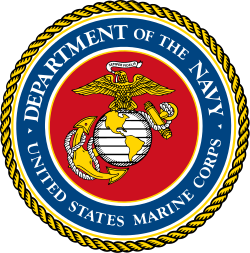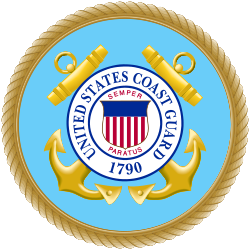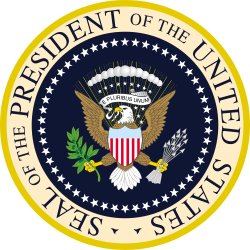Marine One
Marine One ist der Funkrufname eines Luftfahrzeugs des United States Marine Corps (USMC), das den Präsidenten der Vereinigten Staaten von Amerika an Bord hat.[1] Traditionell werden die Hubschrauber, welche den Präsidenten fliegen, vom Marine Corps gestellt. Die Flächenflugzeuge des Präsidentens hingegen werden typischerweise von der Air Force gestellt und somit als Air Force One bezeichnet, obwohl die Marine Corps ebenfalls Flächenflugzeuge betreibt, mit denen der Präsident theoretisch fliegen könnte.[2][3]
Geschichte
Der erste Flug eines Helikopters, der den US-amerikanischen Präsidenten beförderte, war 1957 während der Amtszeit von Dwight D. Eisenhower. Hierfür wurde eine militärische H-13 Sioux verwendet.
Die H-13 wurde dann 1958 durch eine H-34 ersetzt; die Sea King flog als erstes Luftfahrzeug unter dem Funkrufnamen Marine One im Jahre 1961. Vor 1976 teilten sich die US Army und das USMC die Verantwortlichkeit für die Flüge des Präsidenten, wobei das USMC auch das Rufzeichen Army One verwendete, wenn der Präsident an Bord war.
Hubschrauber

Bei den Hubschraubern handelt es sich um Sikorsky H-3 Sea Kings oder die neueren kleineren Sikorsky VH-60 White Hawk. Beide Muster sollten durch Lockheed Martin VH-71 (US101) ersetzt werden; dieser Plan wurde jedoch wegen erhöhter Kosten am 6. April 2009 verworfen.[4]
Nach Beendigung des Lockheed-Martin-VH-71-Projekts ist geplant, 21 Sikorsky VH-92 zu beschaffen. Der Erstflug der speziell ausgestatteten Präsidentenversion war für 2017 geplant. Bis Ende 2023 sollen alle 21 Exemplare ausgeliefert sein.[5]
Die Farbgebung ist dunkelgrün bis zum oberen Fünftel, wo die Hubschrauber weiß lackiert sind. Seitlich ist in Weiß „United States of America“ zu lesen. Am Hauptrotor befindet sich die Flagge der Vereinigten Staaten, an der Seitenwand unter dem Pilotenfenster das Siegel des Präsidenten.
Einsatz
Marine One wird aus einer Flotte von 19 Fluggeräten ausgewählt. Hierfür ist ausschließlich die auf der Marine Corps Base Quantico nahe Triangle, VA, stationierte Staffel HMX-1 „Nighthawks“ zuständig. Über 800 Marines sind mit der Flotte für Marine One befasst.
Marine One wird immer von zwei baugleichen Helikoptern der Staffel begleitet, um Attentate abwehren zu können. Alle Besatzungsmitglieder und das Wartungspersonal der HMX-1 müssen den positiven Befund einer intensiven Zuverlässigkeitsüberprüfung, die sogenannte Yankee White security clearance, vorweisen. Hierfür sind zum Beispiel die US-Staatsbürgerschaft sowie eine unzweifelhafte Loyalität gegenüber dem Staat zwingend erforderlich.
Sobald Marine One an einem Zielort landet, wird sie von einem Soldaten des USMC in Gala-Uniform empfangen.
Marine Two
Befördert ein Luftfahrzeug des Marine Corps den Vizepräsidenten, so ist sein Rufzeichen Marine Two.
Literatur
- Neuer US-Präsidenten-Heli VH-92 A: Erstflug absolviert. Die zukünftige „Marine One“ fliegt – ab 2020 mit einem Präsidenten und zwei CT7-86A-Triebwerken an Bord. In: FliegerRevue Nr. 11/2017, S. 33
- Lockheed Martin's new Generation 'Marine One'. In: AIR International, Vol. 99, No. 2 vom August 2020, S. 52–57
Weblinks
Einzelnachweise
- ↑ faa.gov abgerufen am 17. November 2016
- ↑ Lucy Rodgers, Dominic Bailey, Gerry Fletcher, Sandra Rodriguez Chillida, Irene de la Torre Arenas: Donald Trump's UK visit: What’s he bringing with him? In: BBC News. 2. Dezember 2019 (bbc.com [abgerufen am 5. Januar 2021]).
- ↑ Air Force One. In: whitehouse.gov. Abgerufen am 5. Januar 2021 (englisch).
- ↑ Obama review threatens presidential helicopter deal, 24. September 2009 (Memento vom 2. März 2009 im Internet Archive)
- ↑ Presidential helicopter passes CDR milestone, 27. Juli 2016 (Memento vom 27. Juli 2016 im Internet Archive)
Auf dieser Seite verwendete Medien
U.S. Department of The Army Emblem.
- In the center is a Roman cuirass below a vertical unsheathed sword, point up, the pommel resting on the neck opening of the cuirass and a Phrygian cap supported on the sword point, all between on the right an esponton and on the left a musket with fixed bayonet crossed in saltire behind the cuirass and passing under the sword guard.
- To the right of the cuirass and esponton is a flag of unidentified designs with cords and tassels, on a flagstaff with spearhead, above a cannon barrel, the muzzle end slanting upward behind the cuirass, in front of the drum, with two drumsticks and the fly end of the flag draped over the drumhead; below, but partly in front of the cannon barrel, is a pile of three cannon balls.
- To the left of the cuirass and musket is a national color of the Revolutionary War period, with cords and tassels, on a flagstaff with spearhead, similarly arranged above a mortar on a carriage, the mortar facing inward and in front of the lower portion of the color and obscuring the lower part of it; below the mortar are two bomb shells placed side by side.
- Centered above the Phrygian cap is a rattlesnake holding in its mouth a scroll inscribed "This We'll Defend."
- Centered below the cuirass are the Roman numerals "MDCCLXXVIII."
- For differences between this text description and the emblem shown above, see "Army Seal vs. Army Emblem", below.
Seal of United States Department of the Air Force - military department for the United States Air Force and the United States Space Force
Seal of United States Department of the Air Force - military department for the United States Air Force and the United States Space Force
*Description: On a circular background of fair sky and moderate sea with land in sinister base, a tri-mast square rigged ship under way before a fair breeze with after top-sail furled, commission pennant atop the foremast, National Ensign atop the main, and the commodore's flag atop the mizzen. In front of the ship a luce-type anchor inclined slightly bendwise with the crown resting on the land and, in front of the shank and in back of the dexter fluke, an American bald eagle rising to sinister regarding to dexter, one foot on the ground, the other resting on the anchor near the shank; all in proper colors. The whole within a blue annulet bearing the inscription "Department of the Navy" at the top and "United States of America" at the bottom, separated on each side by a mullet and within a rim in the form of a rope; inscription, rope, mullet, and edges of annulet all gold. *Background: The policy for use of the Navy seal and emblem is contained in SECNAV Instr 5030.4 and SECNAV Instr 5030.6. The seal design was approved by the President of the United States by Executive Order 10736 dated October 23, 1957. Request for use of the Navy emblem should be submitted in writing to Defense Printing Service, ATTN: DPSMO, 8725 John Kingman Rd Suite 3239, Fort Belvoir, VA 22060-6220. The telephone number is (703) 767-4218. 1879 version here: http://etc.usf.edu/clipart/54900/54985/54985_seal_navy.htm
Seal of the United States Marine Corps. It is defined in Executive Order 10538 (alternate source) as:
For more information, see here.Standing upon the western hemisphere of the terrestrial globe containing the lines of latitude and topographical outlines of North, Central, and South America, an American bald eagle with wings displayed horizontally and inverted holding in his beak a scroll inscribed with the motto SEMPER FIDELIS, all bronze. Behind the western hemisphere a foul anchor bend sinister-wise with stock, arms, and flukes in slight perspective, all bronze, on a scarlet background and within a dark blue band edged in gold circumscribed by a gold rope rim and inscribed DEPARTMENT OF THE NAVY • UNITED STATES MARINE CORPS in gold letters. The central device of the seal is the emblem of the United States Marine Corps.
Seal of the United States Marine Corps. It is defined in Executive Order 10538 (alternate source) as:
For more information, see here.Standing upon the western hemisphere of the terrestrial globe containing the lines of latitude and topographical outlines of North, Central, and South America, an American bald eagle with wings displayed horizontally and inverted holding in his beak a scroll inscribed with the motto SEMPER FIDELIS, all bronze. Behind the western hemisphere a foul anchor bend sinister-wise with stock, arms, and flukes in slight perspective, all bronze, on a scarlet background and within a dark blue band edged in gold circumscribed by a gold rope rim and inscribed DEPARTMENT OF THE NAVY • UNITED STATES MARINE CORPS in gold letters. The central device of the seal is the emblem of the United States Marine Corps.
United States Coast Guard Seal, in correct PMS colors. This emblem shall only be used in accordance with the Coast Guard Heraldry Manual, and is not to be reproduced commercially without prior approval of the U.S. Coast Guard.
United States Coast Guard Seal, in correct PMS colors. This emblem shall only be used in accordance with the Coast Guard Heraldry Manual, and is not to be reproduced commercially without prior approval of the U.S. Coast Guard.
A VH-60N Whitehawk executive transport helicopter, assigned to Marine Helicopter Squadron One (HMX-1), flies over the Potomac River in Washington, D.C., en route to the White House. The VH-60N is a twin engine, all-weather helicopter that supports the executive transport mission for the President of the United States.
Bergen Belsen Besuch von Reagan
An H-3 Sea King helicopter used by the President of the United States as Marine One.










